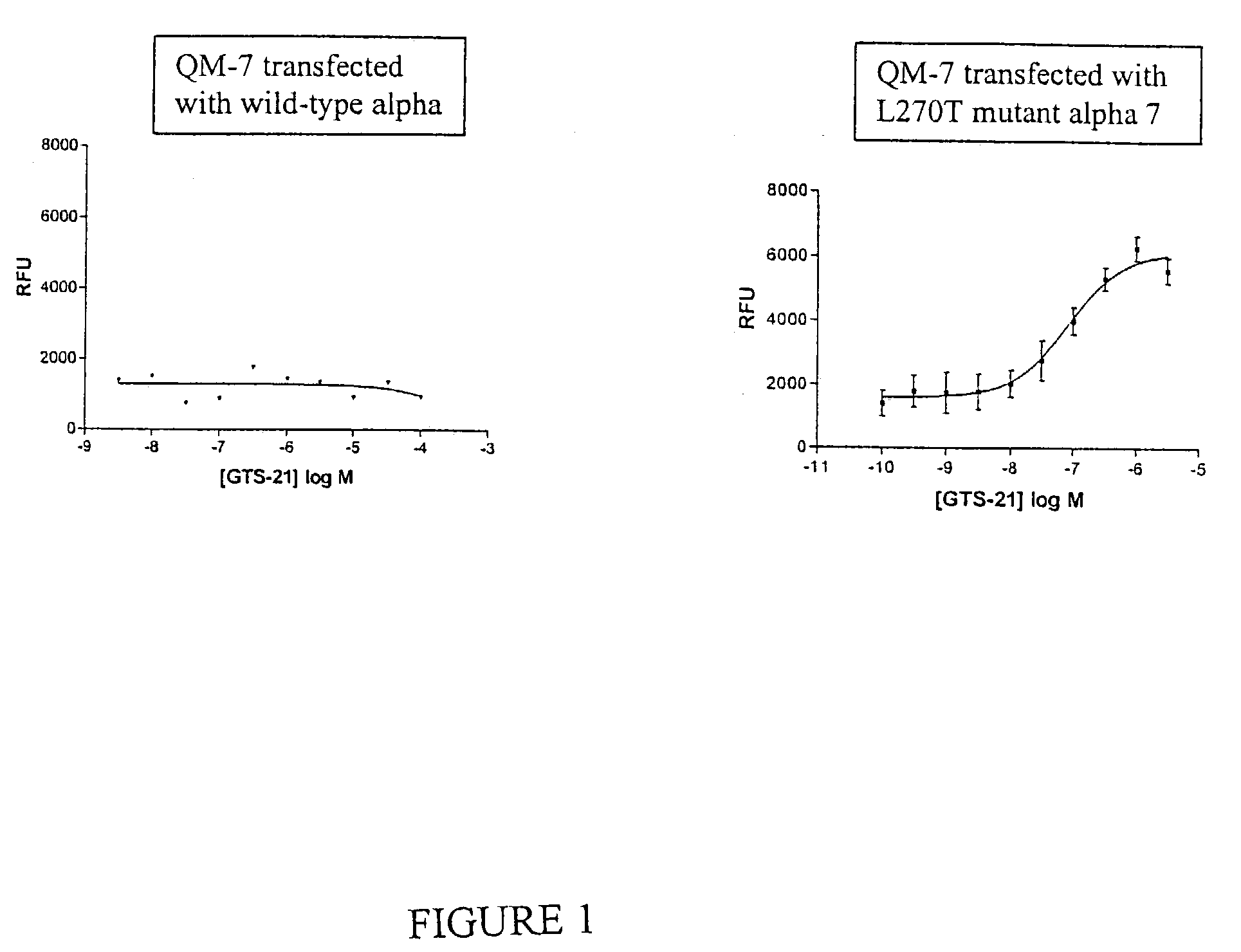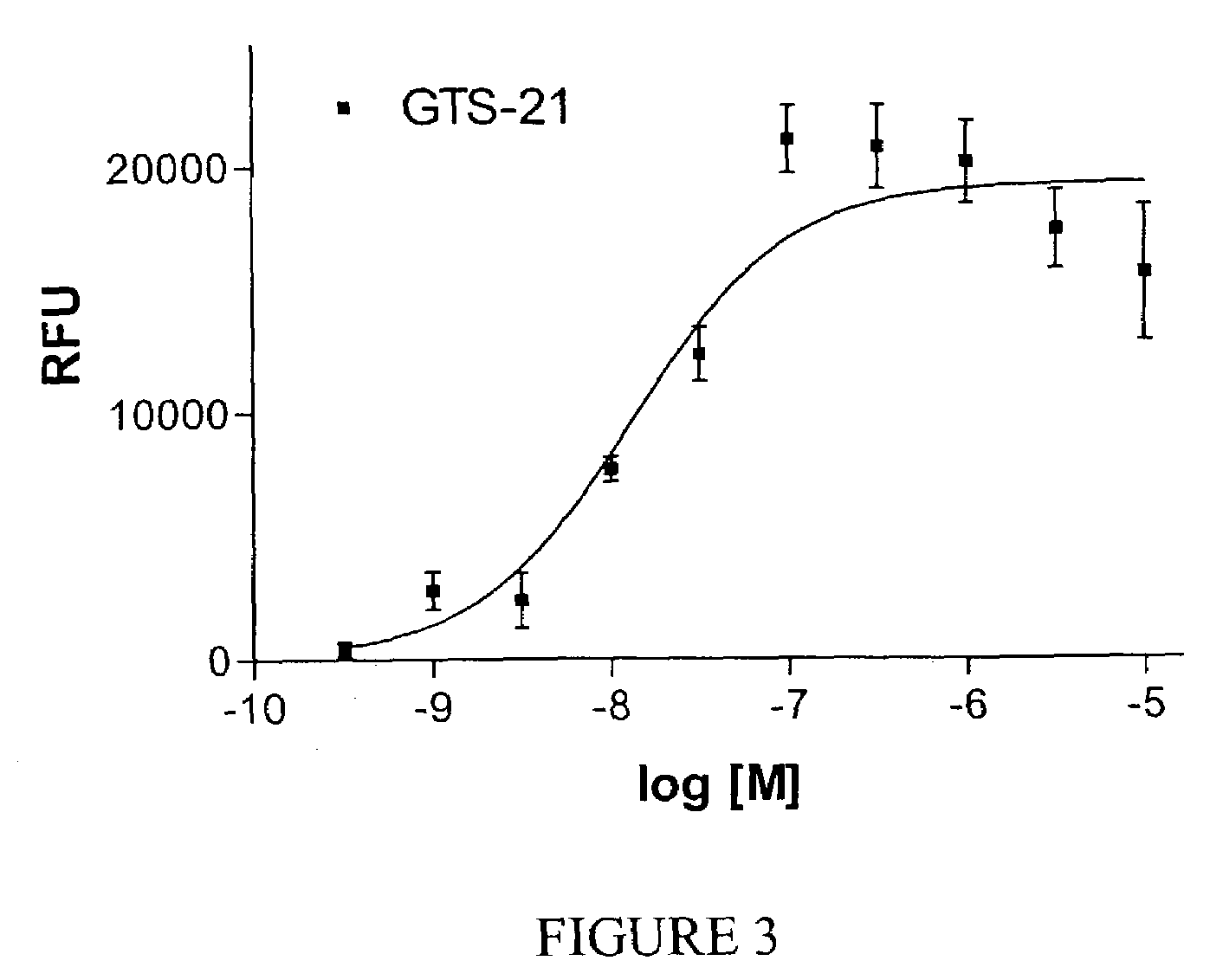QM-7 and QT-6 cells transfected with mutant cell surface expressed channel receptors and assays using the transfected cells
a cell surface and receptor technology, applied in the field of qm7 or qt6 cells, can solve the problems of time-consuming patch-clamp analysis, low throughput, and inability to screen compound libraries
- Summary
- Abstract
- Description
- Claims
- Application Information
AI Technical Summary
Benefits of technology
Problems solved by technology
Method used
Image
Examples
example i
Construction of Human Alpha 7 Mutation L270T
[0106]Wild type human alpha 7 coding sequence was PCR amplified from human hippocampus cDNA (Clontech) and cloned into Invitrogen expression vector pcDNA 3.1 V5 / His TOPO. The clones containing the PCR fragment in the right orientation (5′end downstream of CMV promoter) were chosen and sequenced. The clone shown to encode an identical protein sequence to published human alpha 7 sequence was used to construct L270T mutant.
[0107]To create the L270T mutant, the following primers were used to mutagenize wild type human alpha 7:
[0108]
HSAlpha7-14: 5′GGGATAACAGTCTTAACTTCTCTTACCGTCTTCATGCTGCTCCGTG 3′(SEQ ID NO: 1)HSAlpha7- 15:5′TGAAGACGGTAAGAGAAGTTAAGACTGTTATCCCCAGGGAAATCTTCTCC(SEQ ID NO: 2)3′
[0109]The mutagenesis and PCR reactions were performed using QuickChange site-directed mutagenesis kit (Stratagene) according to the protocol from the manufacture.
[0110]One clone was sequence verified to contain the desired mutation L270T as shown below an...
example ii
Construction of Rat Alpha 7 Mutation L270T
[0113]Wild type rat alpha 7 coding sequence was PCR amplified from rat brain cDNA and cloned into Invitrogen expression vector pcDNA 3.1 V5 / His TOPO. The clones containing the PCR fragment in the right orientation (5′end downstream of CMV promoter) were chosen and sequenced. The clone shown to encode an identical protein sequence to published rat alpha 7 sequence (Seguela, P. et al. Molecular cloning, functional properties, and distribution of rat brain alpha 7: a nicotinic cation channel highly permeable to calcium. J. Neurosci. 13(2), 596-604 (1993)) was used to construct L270T mutant.
[0114]To create the L270T mutant, the following primers were used to mutagenize wild type rat alpha 7:
[0115]
RNAlpha7-muF:5′CTCTTGGAATAACTGTCTTAACTTCTCTGACTGTCTTCATGC(SEQ ID NO:7)3′RNAlpha7-muR:5′GCATGAAGACAGTCAGAGAAGTTAAGACAGTTATTCCAAGAG 3′(SEQ ID NO: 8)
[0116]The mutagenesis and PCR reactions were performed using QuickChange site-directed mutagenesis kit (Str...
example iii
a) Full Length Cloning of Rhesus Monkey Alpha 7
1) RACE the 5′-, 3′-Ends of Rhesus Monkey Alpha 7
[0119]A Gene Racer cDNA library was generated using rhesus monkey brain mRNA (Biochain) according to the standard protocol (Invitrogen). Four primers, mk α 7-5′R, mk α 7-5′N, mk α 7-3′R and mk α 7-3′N, were designed based on Genbank sequence AJ245976 and used to PCR the 5′ and 3′ ends sequences of rhesus monkey alpha 7.
[0120]
RACE primersmk α7-5′R:5′CTCATCTCCACGCTGGCCAGGTGCAG 3′(SEQ ID NO: 11)mk α7-3′R:5′CATGAAGAGGCCGGGAGAGGATAAGGTGCG 3′(SEQ ID NO: 12)Nest primersmk α7-5′N:5′CGCACCTTATCCTCTCCCGGCCTCTTCATG 3′(SEQ ID NO: 13)mk α7-3′N:5′CTGCACCTGGCCAGCGTGGAGATGAG 3′(SEQ ID NO: 14)
[0121]5′ and 3′ RACE PCR reactions were performed on rhesus monkey brain cDNA library using mk α 7-5′R, mk α 7-3′R and Gene Racer 5′-, 3′-RACE primers respectively. The PCR reactions were carried out using PCRx system and platinum HF polymerase (Invitrogen) with the following cycling characteristics: 94° C. for 3′ fo...
PUM
| Property | Measurement | Unit |
|---|---|---|
| Transport properties | aaaaa | aaaaa |
| Ion transport number | aaaaa | aaaaa |
Abstract
Description
Claims
Application Information
 Login to View More
Login to View More - R&D
- Intellectual Property
- Life Sciences
- Materials
- Tech Scout
- Unparalleled Data Quality
- Higher Quality Content
- 60% Fewer Hallucinations
Browse by: Latest US Patents, China's latest patents, Technical Efficacy Thesaurus, Application Domain, Technology Topic, Popular Technical Reports.
© 2025 PatSnap. All rights reserved.Legal|Privacy policy|Modern Slavery Act Transparency Statement|Sitemap|About US| Contact US: help@patsnap.com



